Impact of Molecular Spectroscopy on Carbon Monoxide Abundances from SCIAMACHY
Abstract
1. Introduction
2. Methodology: Forward Modeling and Inversion
2.1. The Forward Model: SWIR Radiative Transfer
2.1.1. Absorption Cross Section and Line Profiles
2.1.2. Spectroscopic Line Data
2.2. Inversion and Its Implementation—BIRRA
2.3. Data Preparation and Postprocessing
3. Results
3.1. Spectral Fitting Residuals
3.1.1. Single Orbits
3.1.2. Regional Scale
3.2. Differences in Mole Fractions
3.3. Comparison to NDACC and TCCON
4. Summary and Conclusions
Author Contributions
Funding
Acknowledgments
Conflicts of Interest
Abbreviations
| BIRRA | Beer Infrared Retrieval Algorithm |
| GARLIC | Generic Atmospheric Radiation Line-by-line Infrared Code |
| G15 | GEISA 2015 spectroscopic database |
| H16 | HITRAN 2016 spectroscopic database |
| IR | infrared |
| lbl | line-by-line |
| MIR | mid infrared |
| Py4CAtS | PYthon scripts for Computational ATmospheric Spectroscopy |
| RTN | Rautian line profile |
| SCIAMACHY | Scanning Imaging Absorption SpectroMeter for Atmospheric CHartographY |
| SEOM | SEOM – Improved Atmospheric Spectroscopy (IAS) database |
| SDV | speed-dependent Voigt line profile |
| SDVM | speed-dependent Voigt line profile with line-mixing |
| SDRM | speed-dependent Rautian line profile with line-mixing |
| SWIR | shortwave infrared |
| VGT | Voigt line profile |
| xCO | carbon monoxide (CO) column-averaged dry-air mole fraction |
Appendix A. Impact on Retrieved and Co-Retrieved Quantities
Appendix A.1. Differences in the Column Scaling Factors


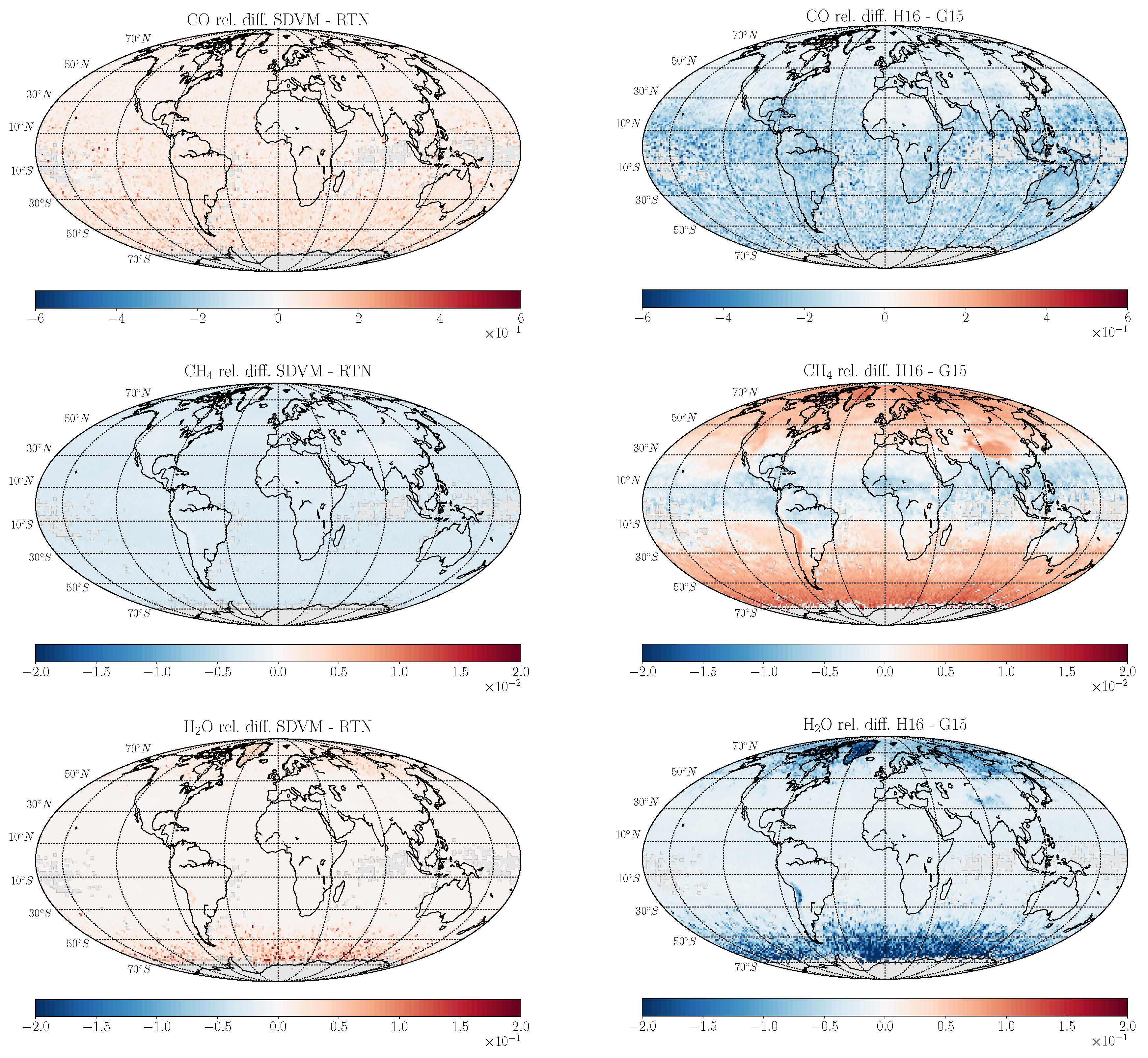
Appendix A.2. Global Map of CO Mole Fractions and Errors
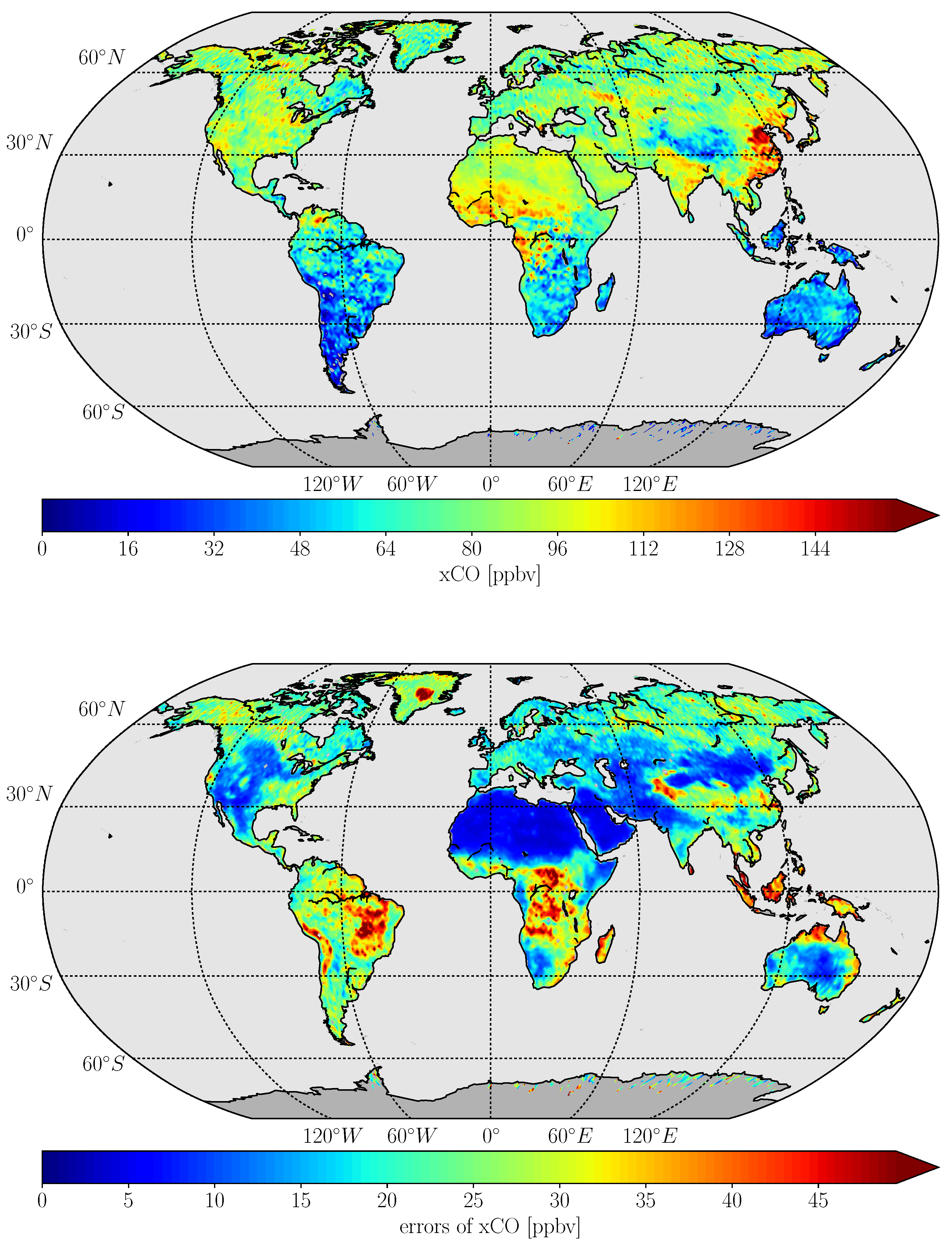
Appendix A.3. Line Parameters in SEOM and HITRAN 2016
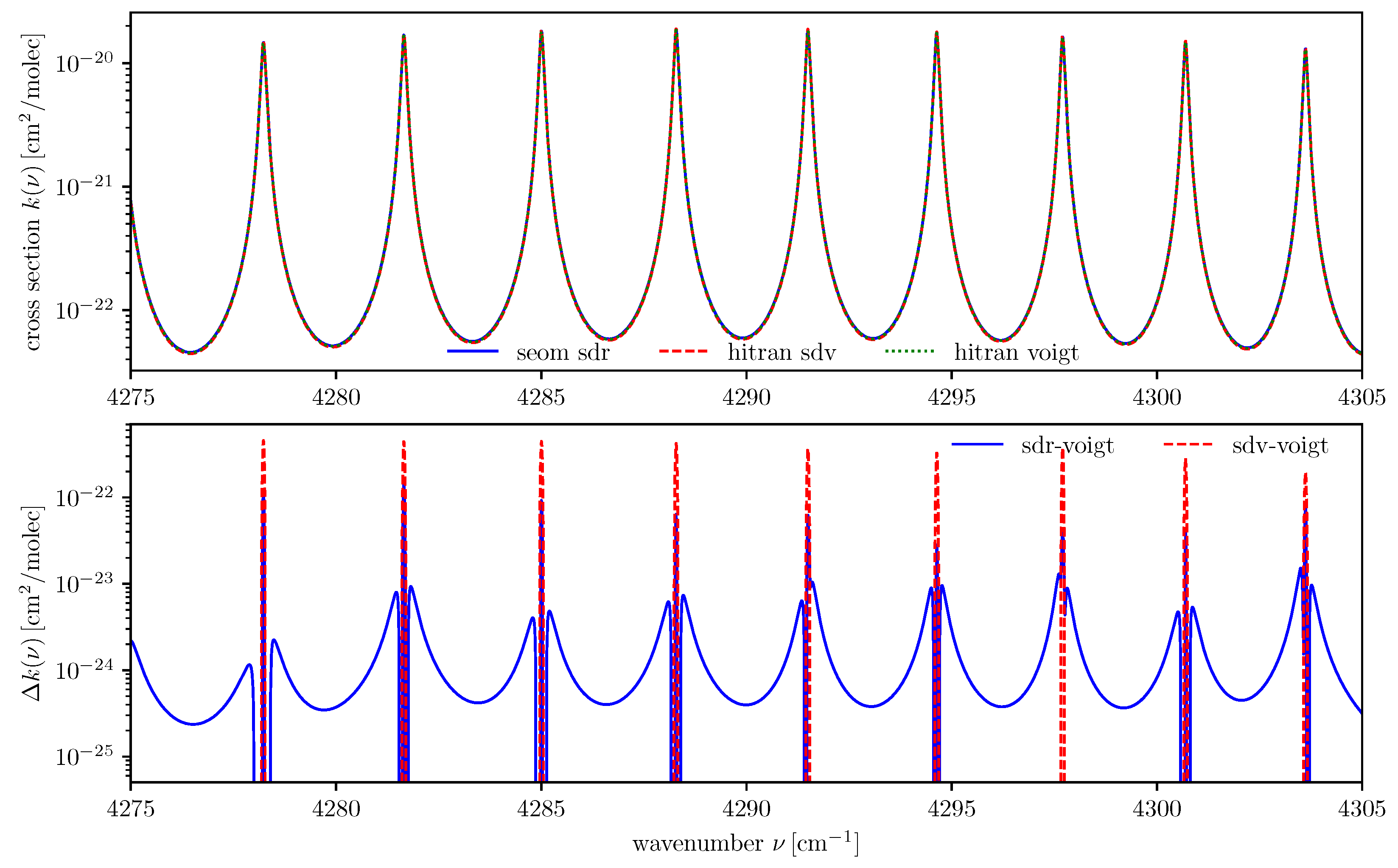
Appendix B. NDACC Data Providers
| NDACC Site | Coorperating Institutions |
|---|---|
| Bremen | Prof Dr Justus Notholt |
| Institute of Environmental Physics; University of Bremen, Germany | |
| Zugspitze | Dr Ralf Sussmann |
| Institute for Meteorology and Climate Research; Karlsruhe Institute of Technology, Germany | |
| Izana | Dr Emilio Cuevas Agulló |
| Izana Atmospheric Research Center; AEMET – Meteorological State Agency, Spain | |
| Jungfraujoch | Dr Emmanuel Mahieua |
| University of Liége, Belgium | |
| Kiruna | Dr Uwe Raffalski |
| Institute of Space Physics, Sweden | |
| Thule | Dr Niels Larsen |
| Danish Climate Center; Danish Meteorological Institute, Denmark | |
| Toronto | Dr Kimberly Strong |
| Department of Physics; University of Toronto, Canada |
Appendix C. TCCON Data Providers
References
- Perrin, A. Review on the existing spectroscopic databases for atmospheric applications. In Spectroscopy from Space; NATO Science Series II; Demaison, J., Sarka, K., Cohen, E., Eds.; Springer Netherlands: Dordrecht, The Netherlands, 2001; Volume 20, pp. 235–258. [Google Scholar]
- Flaud, J.; Oelhaf, H. Infrared spectroscopy and the terrestrial atmosphere. C. R. Phys. 2004, 5, 259–271. [Google Scholar] [CrossRef]
- Payan, S.; de La Noë, J.; Hauchecorne, A.; Camy-Peyret, C. A review of remote sensing techniques and related spectroscopy problems. C. R. Phys. 2005, 6, 825–835. [Google Scholar] [CrossRef]
- Chance, K. Ultraviolet and visible spectroscopy and spaceborne remote sensing of the Earth’s atmosphere. Comp. R. Phys. 2006, 6, 836–847. [Google Scholar] [CrossRef]
- Flaud, J.; Perrin, A.; Picquet-Varrault, B.; Gratien, A.; Orphal, J.; Doussin, J. Quantitative Spectroscopy and Atmospheric Measurements. In Remote Sensing of the Atmosphere for Environmental Security; NATO Security through Science Series; Perrin, A., Ben Sari-Zizi, N., Demaison, J., Eds.; Springer: Dordrecht, The Netherlands, 2006; Volume 14, pp. 107–121. [Google Scholar] [CrossRef]
- Flaud, J.; Picquet-Varrault, B.; Gratien, A.; Orphal, J.; Doussin, J. Synergistic Use of Different Atmospheric Instruments: What about the Spectral Parameters? In Proceedings of the First Atmospheric Science Conference; Lacoste, H., Ed.; ESA: Frascati, Italy, 2006; Volume SP-628. [Google Scholar]
- Feng, X.; Zhao, F.S. Effect of changes of the HITRAN database on transmittance calculations in the near-infrared region. J. Quant. Spectrosc. Radiat. Transf. 2009, 110, 247–255. [Google Scholar] [CrossRef]
- Kratz, D.P. The sensitivity of radiative transfer calculations to the changes in the HITRAN database from 1982 to 2004. J. Quant. Spectrosc. Radiat. Transf. 2008, 109, 1060–1080. [Google Scholar] [CrossRef]
- Galli, A.; Butz, A.; Scheepmaker, R.A.; Hasekamp, O.; Landgraf, J.; Tol, P.; Wunch, D.; Deutscher, N.M.; Toon, G.C.; Wennberg, P.O.; et al. CH4, CO, and H2O spectroscopy for the Sentinel-5 Precursor mission: An assessment with the Total Carbon Column Observing Network measurements. Atmos. Meas. Tech. 2012, 5, 1387–1398. [Google Scholar] [CrossRef]
- Scheepmaker, R.A.; Frankenberg, C.; Galli, A.; Butz, A.; Schrijver, H.; Deutscher, N.M.; Wunch, D.; Warneke, T.; Fally, S.; Aben, I. Improved water vapour spectroscopy in the 4174–4300 cm−1 region and its impact on SCIAMACHY HDO/H2O measurements. Atmos. Meas. Tech. 2013, 6, 879–894. [Google Scholar] [CrossRef]
- Checa-García, R.; Landgraf, J.; Galli, A.; Hase, F.; Velazco, V.; Tran, H.; Boudon, V.; Alkemade, F.; Butz, A. Mapping spectroscopic uncertainties into prospective methane retrieval errors from Sentinel-5 and its precursor. Atmos. Meas. Tech. 2015, 8, 3617–3629. [Google Scholar] [CrossRef]
- Gordon, I.; Rothman, L.; Hill, C.; Kochanov, R.; Tan, Y.; Bernath, P.; Birk, M.; Boudon, V.; Campargue, A.; Chance, K.; et al. The HITRAN2016 molecular spectroscopic database. J. Quant. Spectrosc. Radiat. Transf. 2017, 203, 3–69. [Google Scholar] [CrossRef]
- Jacquinet-Husson, N.; Armante, R.; Scott, N.; Chédin, A.; Crépeau, L.; Boutammine, C.; Bouhdaoui, A.; Crevoisier, C.; Capelle, V.; Boonne, C.; et al. The 2015 edition of the GEISA spectroscopic database. J. Mol. Spectrosc. 2016, 327, 31–72, New Visions of Spectroscopic Databases, Volume II. [Google Scholar] [CrossRef]
- Pickett, H.; Poynter, R.; Cohen, E.; Delitsky, M.; Pearson, J.; Müller, H. Submillimeter, millimeter, and microwave spectral line catalog. J. Quant. Spectrosc. Radiat. Transf. 1998, 60, 883–890. [Google Scholar] [CrossRef]
- Endres, C.P.; Schlemmer, S.; Schilke, P.; Stutzki, J.; Müller, H.S. The Cologne Database for Molecular Spectroscopy, CDMS, in the Virtual Atomic and Molecular Data Centre, VAMDC. J. Mol. Spectrosc. 2016, 327, 95–104, New Visions of Spectroscopic Databases, Volume II. [Google Scholar] [CrossRef]
- Nikitin, A.; Lyulin, O.; Mikhailenko, S.; Perevalov, V.; Filippov, N.; Grigoriev, I.; Morino, I.; Yokota, T.; Kumazawa, R.; Watanabe, T. GOSAT-2009 methane spectral line list in the 5550–6236 cm−1 range. J. Quant. Spectrosc. Radiat. Transf. 2010, 111, 2211–2224. [Google Scholar] [CrossRef]
- Campargue, A.; Leshchishina, O.; Wang, L.; Mondelain, D.; Kassi, S.; Nikitin, A. Refinements of the WKMC empirical line lists (5852–7919 cm−1) for methane between 80 K and 296 K. J. Quant. Spectrosc. Radiat. Transf. 2012, 113, 1855–1873. [Google Scholar] [CrossRef]
- Nikitin, A.; Lyulin, O.; Mikhailenko, S.; Perevalov, V.; Filippov, N.; Grigoriev, I.; Morino, I.; Yoshida, Y.; Matsunaga, T. GOSAT-2014 methane spectral line list. J. Quant. Spectrosc. Radiat. Transf. 2015, 154, 63–71. [Google Scholar] [CrossRef]
- Birk, M.; Wagner, G.; Loos, J.; Mondelain, D.; Campargue, A. ESA SEOM–IAS—Spectroscopic Parameters Database 2.3 μm Region [Data set]. Zenodo. 2017. Available online: https://zenodo.org/record/1009126#.XnyN7q19iXl (accessed on 8 March 2019).
- Buchwitz, M.; Burrows, J. Retrieval of CH4, CO, and CO2 total column amounts from SCIAMACHY near-infrared nadir spectra: Retrieval algorithm and first results. In Proceedings of the 10th International Symposium Remote Sensing—Remote Sensing of Clouds and the Atmosphere VIII, Barcelona, Spain, 8–12 September 2003. [Google Scholar]
- Pan, L.; Gille, J.; Edwards, D.; Bailey, P.; Rodgers, C. Retrieval of tropospheric carbon monoxide for the MOPITT experiment. J. Geophys. Res. 1998, 103, 32277–32290. [Google Scholar] [CrossRef]
- Kuze, A.; Suto, H.; Nakajima, M.; Hamazaki, T. Thermal and near infrared sensor for carbon observation Fourier-transform spectrometer on the Greenhouse Gases Observing Satellite for greenhouse gases monitoring. Appl. Opt. 2009, 48, 6716–6733. [Google Scholar] [CrossRef]
- Crisp, D.; Atlas, R.; Breon, F.M.; Brown, L.; Burrows, J.; Ciais, P.; Connor, B.; Doney, S.; Fung, I.; Jacob, D.; et al. The Orbiting Carbon Observatory (OCO) mission. Adv. Space Res. 2004, 34, 700–709. [Google Scholar] [CrossRef]
- Yang, D.; Liu, Y.; Cai, Z.; Chen, X.; Yao, L.; Lu, D. First Global Carbon Dioxide Maps Produced from TanSat Measurements. Adv. Atmos. Sci. 2018, 35, 621–623. [Google Scholar] [CrossRef]
- Landgraf, J.; aan de Brugh, J.; Scheepmaker, R.; Borsdorff, T.; Hu, H.; Houweling, S.; Butz, A.; Aben, I.; Hasekamp, O. Carbon monoxide total column retrievals from TROPOMI shortwave infrared measurements. Atmos. Meas. Tech. 2016, 9, 4955–4975. [Google Scholar] [CrossRef]
- Frankenberg, C.; Warneke, T.; Butz, A.; Aben, I.; Hase, F.; Spietz, P.; Brown, L.R. Pressure broadening in the 2ν3 band of methane and its implication on atmospheric retrievals. Atm. Chem. Phys. 2008, 8, 5061–5075. [Google Scholar] [CrossRef]
- Frankenberg, C.; Bergamaschi, P.; Butz, A.; Houweling, S.; Meirink, J.F.; Notholt, J.; Petersen, A.K.; Schrijver, H.; Warneke, T.; Aben, I. Tropical methane emissions: A revised view from SCIAMACHY onboard ENVISAT. Geophys. Res. Letters 2008, 35, L15811. [Google Scholar] [CrossRef]
- Gloudemans, A.; Schrijver, H.; Hasekamp, O.; Aben, I. Error analysis for CO and CH4 total column retrievals from SCIAMACHY 2.3 μm spectra. Atm. Chem. Phys. 2008, 8, 3999–4017. [Google Scholar] [CrossRef]
- Oyafuso, F.; Payne, V.; Drouin, B.; Devi, V.; Benner, D.; Sung, K.; Yu, S.; Gordon, I.; Kochanov, R.; Tan, Y.; et al. High accuracy absorption coefficients for the Orbiting Carbon Observatory-2 (OCO-2) mission: Validation of updated carbon dioxide cross-sections using atmospheric spectra. J. Quant. Spectrosc. Radiat. Transf. 2017, 203, 213–223, HITRAN2016 Special Issue. [Google Scholar] [CrossRef]
- Borsdorff, T.; aan de Brugh, J.; Schneider, A.; Lorente, A.; Birk, M.; Wagner, G.; Kivi, R.; Hase, F.; Feist, D.G.; Sussmann, R.; et al. Improving the TROPOMI CO data product: Update of the spectroscopic database and destriping of single orbits. Atmos. Meas. Tech. 2019, 12, 5443–5455. [Google Scholar] [CrossRef]
- Buchwitz, M.; de Beek, R.; Bramstedt, K.; Noël, S.; Bovensmann, H.; Burrows, J.P. Global carbon monoxide as retrieved from SCIAMACHY by WFM-DOAS. Atm. Chem. Phys. 2004, 4, 1945–1960. [Google Scholar] [CrossRef]
- Buchwitz, M.; de Beek, R.; Noël, S.; Burrows, J.P.; Bovensmann, H.; Bremer, H.; Bergamaschi, P.; Körner, S.; Heimann, M. Carbon monoxide, methane and carbon dioxide columns retrieved from SCIAMACHY by WFM-DOAS: Year 2003 initial data set. Atm. Chem. Phys. 2005, 5, 3313–3329. [Google Scholar] [CrossRef]
- Frankenberg, C.; Platt, U.; Wagner, T. Retrieval of CO from SCIAMACHY onboard ENVISAT: Detection of strongly polluted areas and seasonal patterns in global CO abundances. Atm. Chem. Phys. 2005, 5, 1639–1644. [Google Scholar] [CrossRef]
- Gloudemans, A.; Schrijver, H.; Kleipool, Q.; van den Broek, M.; Straume, A.; Lichtenberg, G.; van Hees, R.; Aben, I.; Meirink, J. The impact of SCIAMACHY near-infrared instrument calibration on CH4 and CO total columns. Atm. Chem. Phys. 2005, 5, 2369–2383. [Google Scholar] [CrossRef]
- Borsdorff, T.; Tol, P.; Williams, J.E.; de Laat, J.; aan de Brugh, J.; Nédélec, P.; Aben, I.; Landgraf, J. Carbon monoxide total columns from SCIAMACHY 2.3 μm atmospheric reflectance measurements: Towards a full-mission data product (2003–2012). Atmos. Meas. Tech. 2016, 9, 227–248. [Google Scholar] [CrossRef]
- Borsdorff, T.; aan de Brugh, J.; Hu, H.; Nédélec, P.; Aben, I.; Landgraf, J. Carbon monoxide column retrieval for clear-sky and cloudy atmospheres: A full-mission data set from SCIAMACHY 2.3 μm reflectance measurements. Atmos. Meas. Tech. 2017, 10, 1769–1782. [Google Scholar] [CrossRef]
- Gimeno García, S.; Schreier, F.; Lichtenberg, G.; Slijkhuis, S. Near infrared nadir retrieval of vertical column densities: Methodology and application to SCIAMACHY. Atmos. Meas. Tech. 2011, 4, 2633–2657. [Google Scholar] [CrossRef]
- de Laat, A.; Gloudemans, A.; Schrijver, H.; van den Broek, M.; Meirink, J.; Aben, I.; Krol, M. Quantitative analysis of SCIAMACHY carbon monoxide total column measurements. Geophys. Res. Lett. 2006, 33, L07807. [Google Scholar] [CrossRef]
- Lichtenberg, G.; Gimeno García, S.; Schreier, F.; Slijkhuis, S.; Snel, R.; Bovensmann, H. Impact of Level 1 Quality on SCIAMACHY Level 2 Retrieval. In Proceedings of the 38th COSPAR Scientific Assembly, Bremen, Germany, 18–25 July 2010. [Google Scholar]
- Hochstaffl, P.; Schreier, F.; Lichtenberg, G.; Gimeno García, S. Validation of Carbon Monoxide Total Column Retrievals from SCIAMACHY Observations with NDACC/TCCON Ground-Based Measurements. Remote Sens. 2018, 10, 223. [Google Scholar] [CrossRef]
- Goody, R.; Yung, Y. Atmospheric Radiation—Theoretical Basis, 2nd ed.; Oxford University Press: Oxford, UK, 1989. [Google Scholar]
- Liou, K.N. An Introduction to Atmospheric Radiation, 2nd ed.; Academic Press: Cambridge, MA, USA, 2002; p. 583. [Google Scholar]
- Zdunkowski, W.; Trautmann, T.; Bott, A. Radiation in the Atmosphere—A Course in Theoretical Meteorology; Cambridge University Press: Cambridge, UK, 2007. [Google Scholar]
- Armstrong, B. Spectrum Line Profiles: The Voigt Function. J. Quant. Spectrosc. Radiat. Transf. 1967, 7, 61–88. [Google Scholar] [CrossRef]
- Humlíček, J. Optimized computation of the Voigt and complex probability function. J. Quant. Spectrosc. Radiat. Transf. 1982, 27, 437–444. [Google Scholar] [CrossRef]
- Weideman, J. Computation of the Complex Error Function. SIAM J. Num. Anal. 1994, 31, 1497–1518. [Google Scholar] [CrossRef]
- Schreier, F. Optimized Implementations of Rational Approximations for the Voigt and Complex Error Function. J. Quant. Spectrosc. Radiat. Transf. 2011, 112, 1010–1025. [Google Scholar] [CrossRef]
- Tennyson, J.; Bernath, P.; Campargue, A.; Császár, A.; Daumont, L.; Gamache, R.; Hodges, J.; Lisak, D.; Naumenko, O.; Rothman, L.; et al. Recommended isolated-line profile for representing high-resolution spectroscopic transitions (IUPAC Technical Report). Pure Appl. Chem. 2014, 86, 1931–1943. [Google Scholar] [CrossRef]
- Berman, P. Speed-dependent collisional width and shift parameters in spectral profiles. J. Quant. Spectrosc. Radiat. Transf. 1972, 12, 1321–1342. [Google Scholar] [CrossRef]
- Boone, C.; Walker, K.; Bernath, P. Speed–dependent Voigt profile for water vapor in infrared remote sensing applications. J. Quant. Spectrosc. Radiat. Transf. 2007, 105, 525–532. [Google Scholar] [CrossRef]
- Boone, C.; Walker, K.; Bernath, P. An efficient analytical approach for calculating line mixing in atmospheric remote sensing applications. J. Quant. Spectrosc. Radiat. Transf. 2011, 112, 980–989. [Google Scholar] [CrossRef]
- Kochanov, V.P. Speed-dependent spectral line profile including line narrowing and mixing. J. Quant. Spectrosc. Radiat. Transf. 2016, 177, 261–268. [Google Scholar] [CrossRef]
- Varghese, P.; Hanson, R. Collisional narrowing effects on spectral line shapes measured at high resolution. Appl. Opt. 1984, 23, 2376–2385. [Google Scholar] [CrossRef]
- Rosenkranz, P. Shape of the 5 mm oxygen band in the atmosphere. IEEE Trans. Antennas Propag. 1975, 23, 498–506. [Google Scholar] [CrossRef]
- Strow, L.L.; Tobin, D.C.; Hannon, S.E. A compilation of first-order line-mixing coefficients for CO2 Q-branches. J. Quant. Spectrosc. Radiat. Transf. 1994, 52, 281–294. [Google Scholar] [CrossRef]
- Dicke, R.H. The Effect of Collisions upon the Doppler Width of Spectral Lines. Phys. Rev. 1953, 89, 472–473. [Google Scholar] [CrossRef]
- Lévy, A.; Lacome, N.; Chackerian, C., Jr. Collisional Line Mixing. In Spectroscopy of the Earth’s Atmosphere and Interstellar Medium; Rao, K., Weber, A., Eds.; Academic Press: Cambridge, MA, USA, 1992; pp. 261–338. [Google Scholar]
- Ngo, N.; Lisak, D.; Tran, H.; Hartmann, J.M. An isolated line-shape model to go beyond the Voigt profile in spectroscopic databases and radiative transfer codes. J. Quant. Spectrosc. Radiat. Transf. 2013, 129, 89–100, Erratum: JQSRT 134, 105 (2014). [Google Scholar] [CrossRef]
- Tran, H.; Ngo, N.; Hartmann, J.M. Efficient computation of some speed-dependent isolated line profiles. J. Quant. Spectrosc. Radiat. Transf. 2013, 129, 199–203, Erratum: JQSRT 134, 104 (2014). [Google Scholar] [CrossRef]
- Malathy Devi, V.; Benner, D.C.; Smith, M.; Mantz, A.; Sung, K.; Brown, L.; Predoi-Cross, A. Spectral line parameters including temperature dependences of self- and air-broadening in the 2-0 band of CO at 2.3μm. J. Quant. Spectrosc. Radiat. Transf. 2012, 113, 1013–1033. [Google Scholar] [CrossRef]
- Rothman, L.; Gordon, I.; Babikov, Y.; Barbe, A.; Benner, D.C.; Bernath, P.; Birk, M.; Bizzocchi, L.; Boudon, V.; Brown, L.; et al. The HITRAN2012 molecular spectroscopic database. J. Quant. Spectrosc. Radiat. Transf. 2013, 130, 4–50. [Google Scholar] [CrossRef]
- Li, G.; Gordon, I.E.; Rothman, L.S.; Tan, Y.; Hu, S.M.; Kassi, S.; Campargue, A.; Medvedev, E.S. Rovibrational line lists for nine isotopologues of the CO molecule in the X1Σ+ ground electronic state. Astrophys. J. Supp. S. 2015, 216, 15. [Google Scholar] [CrossRef]
- Mlawer, E.; Payne, V.; Moncet, J.L.; Delamere, J.; Alvarado, M.; Tobin, D. Development and recent evaluation of the MT-CKD model of continuum absorption. Philos. Trans. Roy. Soc. Lond. Ser. A 2012, 370, 2520–2556. [Google Scholar] [CrossRef] [PubMed]
- Jacquinet-Husson, N.; Crepeau, L.; Armante, R.; Boutammine, C.; Chedin, A.; Scott, N.; Crevoisier, C.; Capelle, V.; Boone, C.; Poulet-Crovisier, N.; et al. The 2009 edition of the GEISA spectroscopic database. J. Quant. Spectrosc. Radiat. Transf. 2011, 112, 2395–2445. [Google Scholar] [CrossRef]
- Kistler, R.; Collins, W.; Saha, S.; White, G.; Woollen, J.; Kalnay, E.; Chelliah, M.; Ebisuzaki, W.; Kanamitsu, M.; Kousky, V.; et al. The NCEP-NCAR 50-Year Reanalysis: Monthly Means CD-ROM and Documentation. Bull. Am. Met. Soc. 2001, 82, 247–267. [Google Scholar] [CrossRef]
- Anderson, G.; Clough, S.; Kneizys, F.; Chetwynd, J.; Shettle, E. AFGL Atmospheric Constituent Profiles (0–120 km ); Technical Report TR-86-0110; Air Force Geophysics Laboratory (AFGL): Hanscom AFB, MA, USA, 1986. [Google Scholar]
- Schreier, F.; Gimeno García, S.; Hedelt, P.; Hess, M.; Mendrok, J.; Vasquez, M.; Xu, J. GARLIC—A General Purpose Atmospheric Radiative Transfer Line-by-Line Infrared-Microwave Code: Implementation and Evaluation. J. Quant. Spectrosc. Radiat. Transf. 2014, 137, 29–50. [Google Scholar] [CrossRef]
- Hamidouche, M.; Lichtenberg, G. In-Flight Retrieval of SCIAMACHY Instrument Spectral Response Function. Remote Sens. 2018, 10, 401. [Google Scholar] [CrossRef]
- Loyola, D. A new cloud recognition algorithm for optical sensors. In Proceedings of the IGARSS ’98. Sensing and Managing the Environment. 1998 IEEE International Geoscience and Remote Sensing. Symposium Proceedings, Seattle, WA, USA, 6–10 July 1998; pp. 572–574. [Google Scholar] [CrossRef]
- Kokhanovsky, A.A.; von Hoyningen-Huene, W.; Rozanov, V.V.; Noël, S.; Gerilowski, K.; Bovensmann, H.; Bramstedt, K.; Buchwitz, M.; Burrows, J.P. The semianalytical cloud retrieval algorithm for SCIAMACHY II. The application to MERIS and SCIAMACHY data. Atm. Chem. Phys. 2006, 6, 4129–4136. [Google Scholar] [CrossRef]
- Hodges, J.L. The significance probability of the Smirnov two-sample test. Ark. Mat. 1958, 3, 469–486. [Google Scholar] [CrossRef]
- Frankenberg, C.; Meirink, J.F.; Bergamaschi, P.; Goede, A.P.H.; Heimann, M.; Körner, S.; Platt, U.; van Weele, M.; Wagner, T. Satellite chartography of atmospheric methane from SCIAMACHY on board ENVISAT: Analysis of the years 2003 and 2004. J. Geophys. Res. 2006, 111, D07303. [Google Scholar] [CrossRef]
- Hochstaffl, P.; Gimeno García, S.; Schreier, F.; Hamidouche, M.; Lichtenberg, G. Validation of Carbon Monoxide Vertical Column Densities Retrieved from SCIAMACHY Infrared Nadir Observations. In Proceedings of the Living Planet Symposium, Prague, Czech Republic, 9–13 May 2016. [Google Scholar]
- Wunch, D.; Toon, G.C.; Sherlock, V.; Deutscher, N.M.; Liu, C.; Feist, D.G.; Wennberg, P.O. Documentation for the 2014 TCCON Data Release (Version GGG2014.R0). CaltechDATA 2015. [Google Scholar] [CrossRef]
- Sussmann, R.; Ostler, A.; Forster, F.; Rettinger, M.; Deutscher, N.M.; Griffith, D.W.T.; Hannigan, J.W.; Jones, N.; Patra, P.K. First intercalibration of column-averaged methane from the Total Carbon Column Observing Network and the Network for the Detection of Atmospheric Composition Change. Atmos. Meas. Tech. 2013, 6, 397–418. [Google Scholar] [CrossRef]
- Kiel, M.; Hase, F.; Blumenstock, T.; Kirner, O. Comparison of XCO abundances from the Total Carbon Column Observing Network and the Network for the Detection of Atmospheric Composition Change measured in Karlsruhe. Atmos. Meas. Tech. 2016, 9, 2223–2239. [Google Scholar] [CrossRef]
- Zhou, M.; Langerock, B.; Vigouroux, C.; Sha, M.K.; Hermans, C.; Metzger, J.M.; Chen, H.; Ramonet, M.; Kivi, R.; Heikkinen, P.; et al. TCCON and NDACC XCO measurements: Difference, discussion and application. Atmos. Meas. Tech. 2019, 12, 5979–5995. [Google Scholar] [CrossRef]
- Sussmann, R.; Buchwitz, M. Initial validation of ENVISAT/SCIAMACHY columnar CO by FTIR profile retrievals at the Ground-Truthing Station Zugspitze. Atm. Chem. Phys. 2005, 5, 1497–1503. [Google Scholar] [CrossRef]
- Sussmann, R.; Stremme, W.; Buchwitz, M.; de Beek, R. Validation of ENVISAT/SCIAMACHY columnar methane by solar FTIR spectrometry at the Ground-Truthing Station Zugspitze. Atm. Chem. Phys. 2005, 5, 2419–2429. [Google Scholar] [CrossRef]
- Buchholz, R.; Deeter, M.; Worden, H.; Gille, J.; Edwards, D.; Hannigan, J.; Jones, N.; Paton-Walsh, C.; Griffith, D.; Smale, D.; et al. Validation of MOPITT carbon monoxide using ground-based Fourier transform infrared spectrometer data from NDACC. Atmos. Meas. Tech. 2017, 10, 1927–1956. [Google Scholar] [CrossRef]
- Rodgers, C.; Connor, B. Intercomparison of remote sounding instruments. J. Geophys. Res. 2003, 108, 4116. [Google Scholar] [CrossRef]
- Coldewey-Egbers, M.; Loyola, D.G.; Koukouli, M.; Balis, D.; Lambert, J.C.; Verhoelst, T.; Granville, J.; van Roozendael, M.; Lerot, C.; Spurr, R.; et al. The GOME-type Total Ozone Essential Climate Variable (GTO-ECV) data record from the ESA Climate Change Initiative. Atmos. Meas. Tech. 2015, 8, 3923–3940. [Google Scholar] [CrossRef]
- Rothman, L.; Jacquemart, D.; Barbe, A.; Benner, D.C.; Birk, M.; Brown, L.; Carleer, M.; Chackerian, C., Jr.; Chance, K.; Coudert, L.; et al. The HITRAN 2004 molecular spectroscopic database. J. Quant. Spectrosc. Radiat. Transf. 2005, 96, 139–204. [Google Scholar] [CrossRef]
- Griffith, D.W.T.; Deutscher, N.M.; Velazco, V.A.; Wennberg, P.O.; Yavin, Y.; Keppel-Aleks, G.; Washenfelder, R.; Toon, G.C.; Blavier, J.F.; Paton-Walsh, C.; et al. TCCON data from Darwin (AU), Release GGG2014.R0. TCCON Data Archive, hosted by CaltechDATA. 2014. Available online: https://data.caltech.edu/records/269l (accessed on 8 March 2019).
- Sherlock, V.; Connor, B.; Robinson, J.; Shiona, H.; Smale, D.; Pollard, D. TCCON data from Lauder (NZ), 120HR, Release GGG2014.R0. TCCON Data Archive, hosted by CaltechDATA. 2014. Available online: https://data.caltech.edu/records/281l (accessed on 8 March 2019).
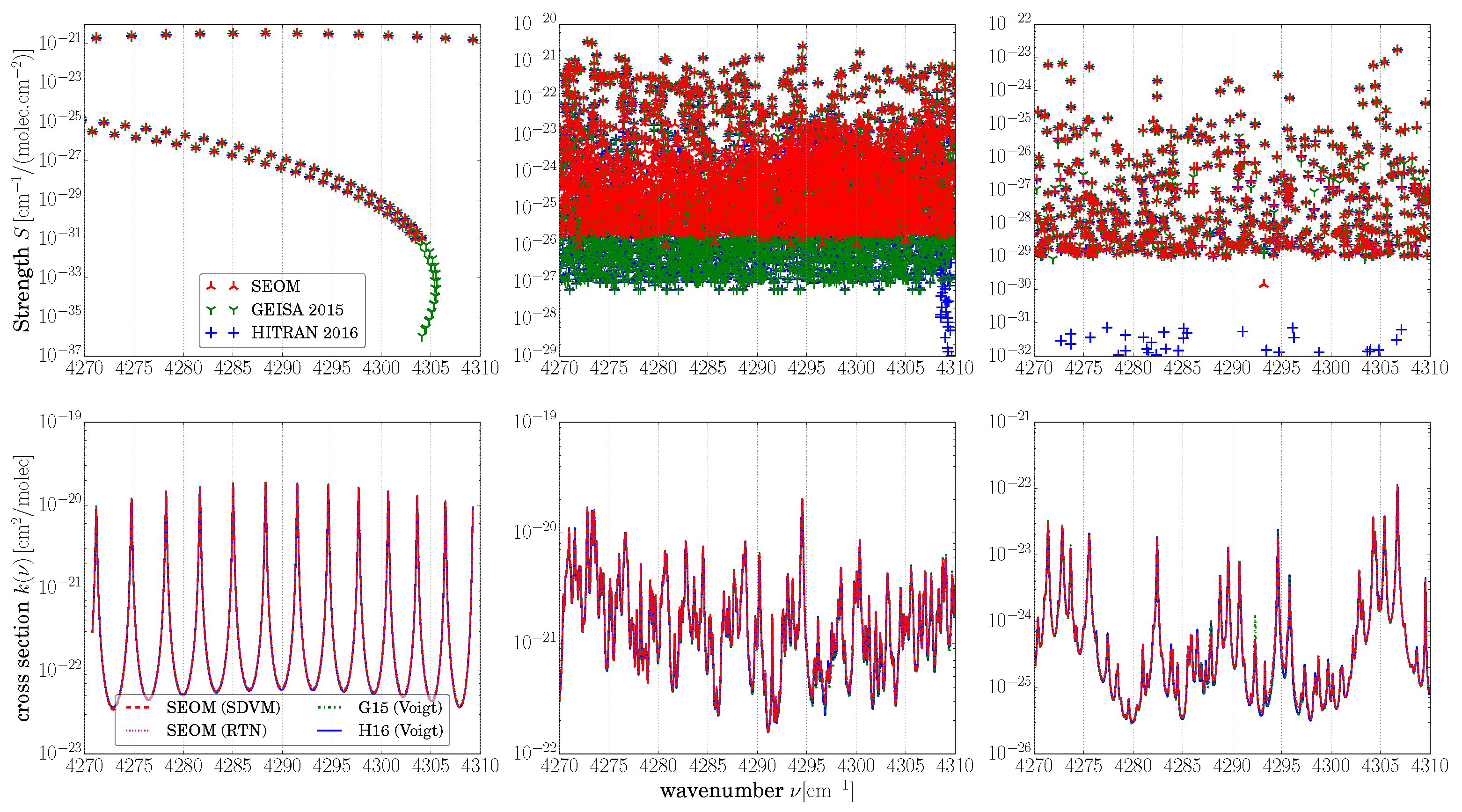
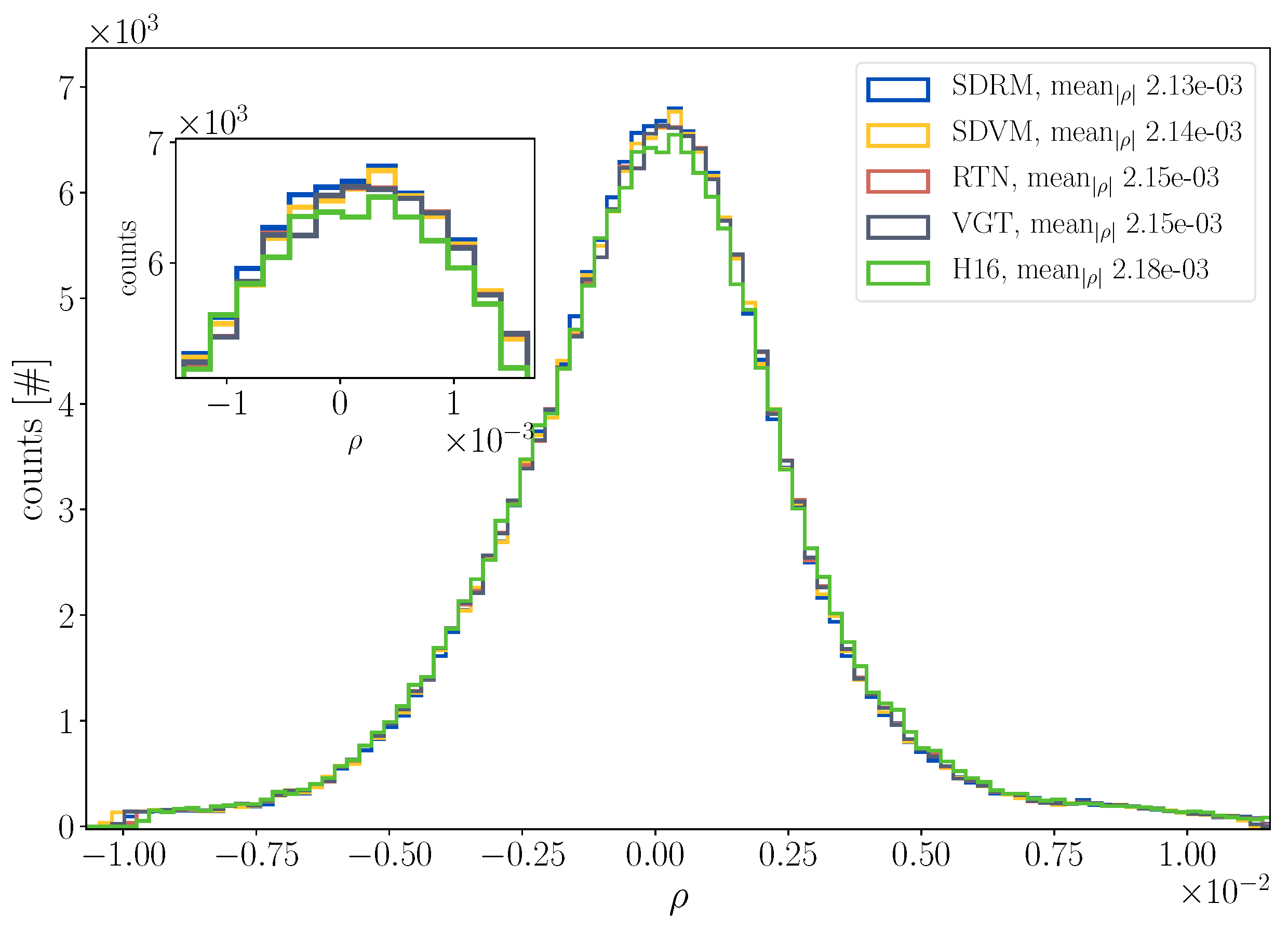
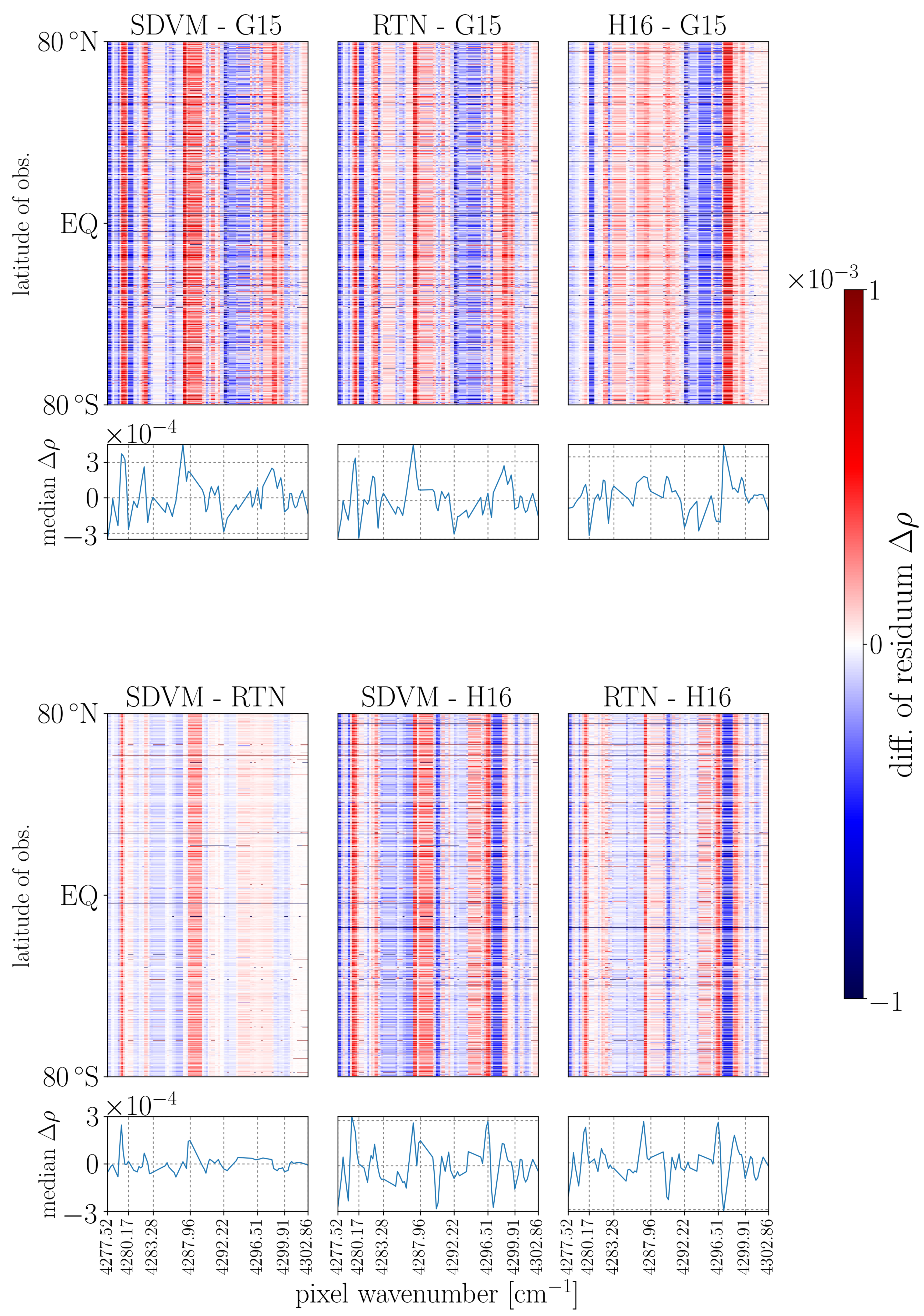
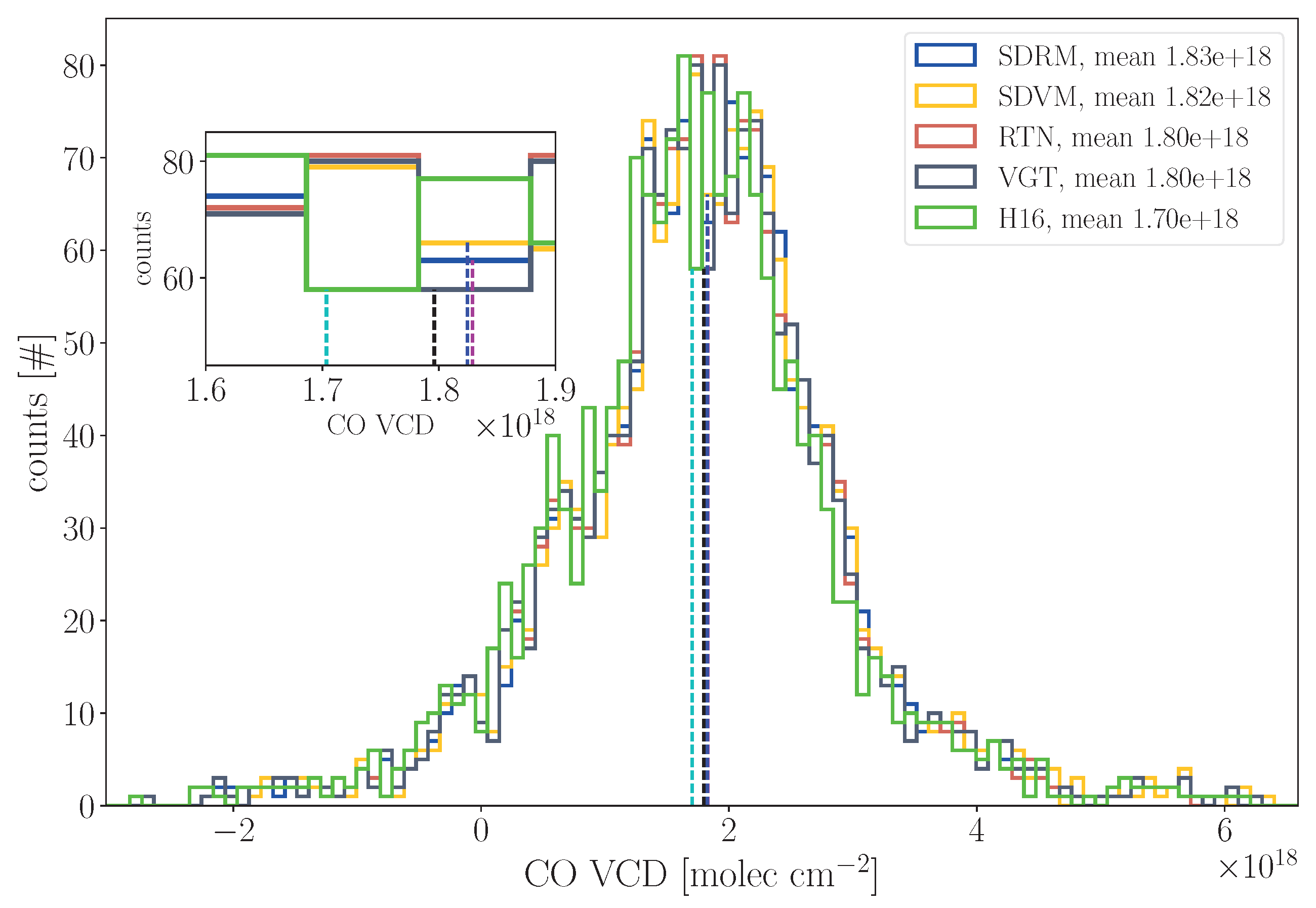
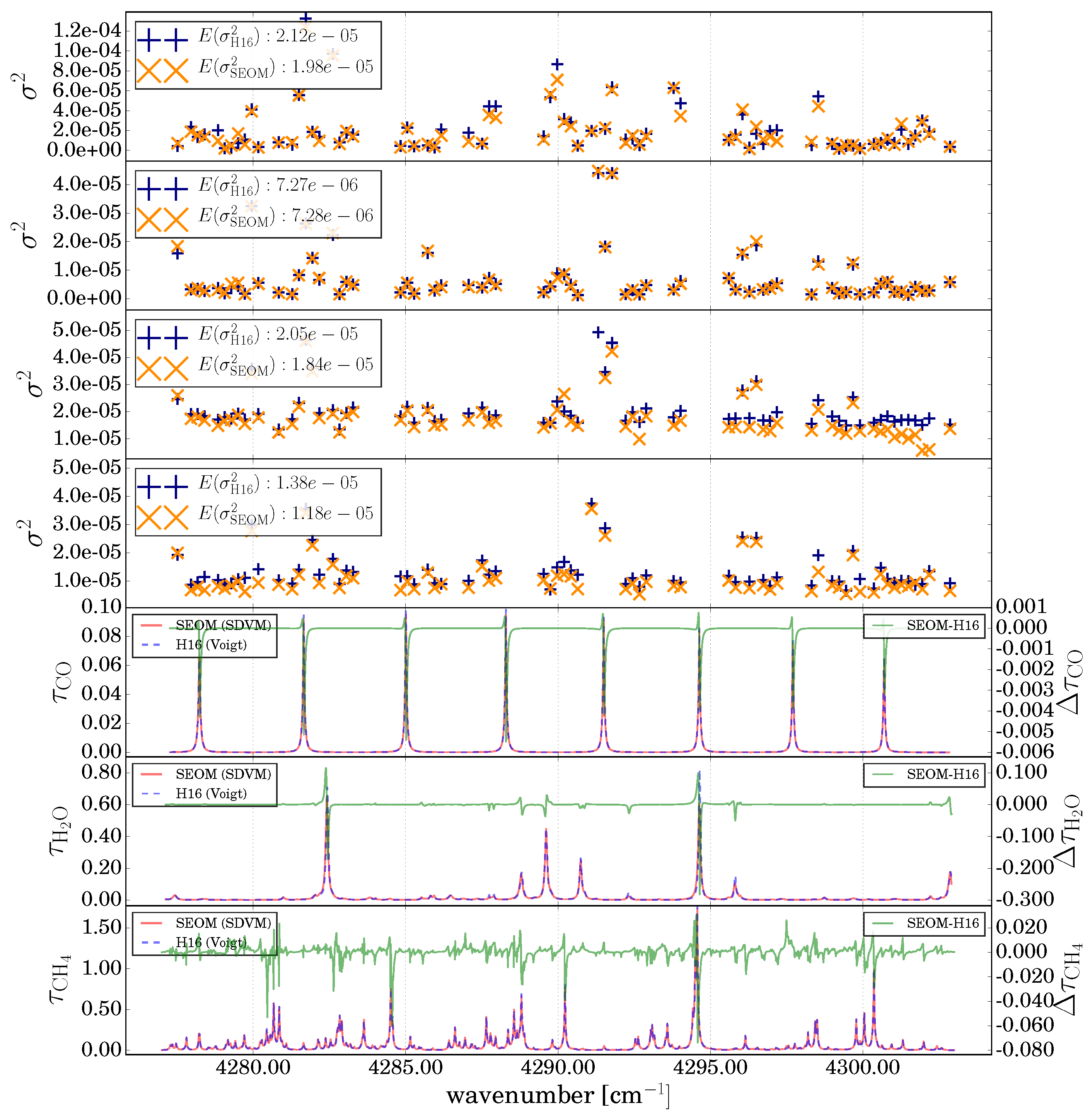
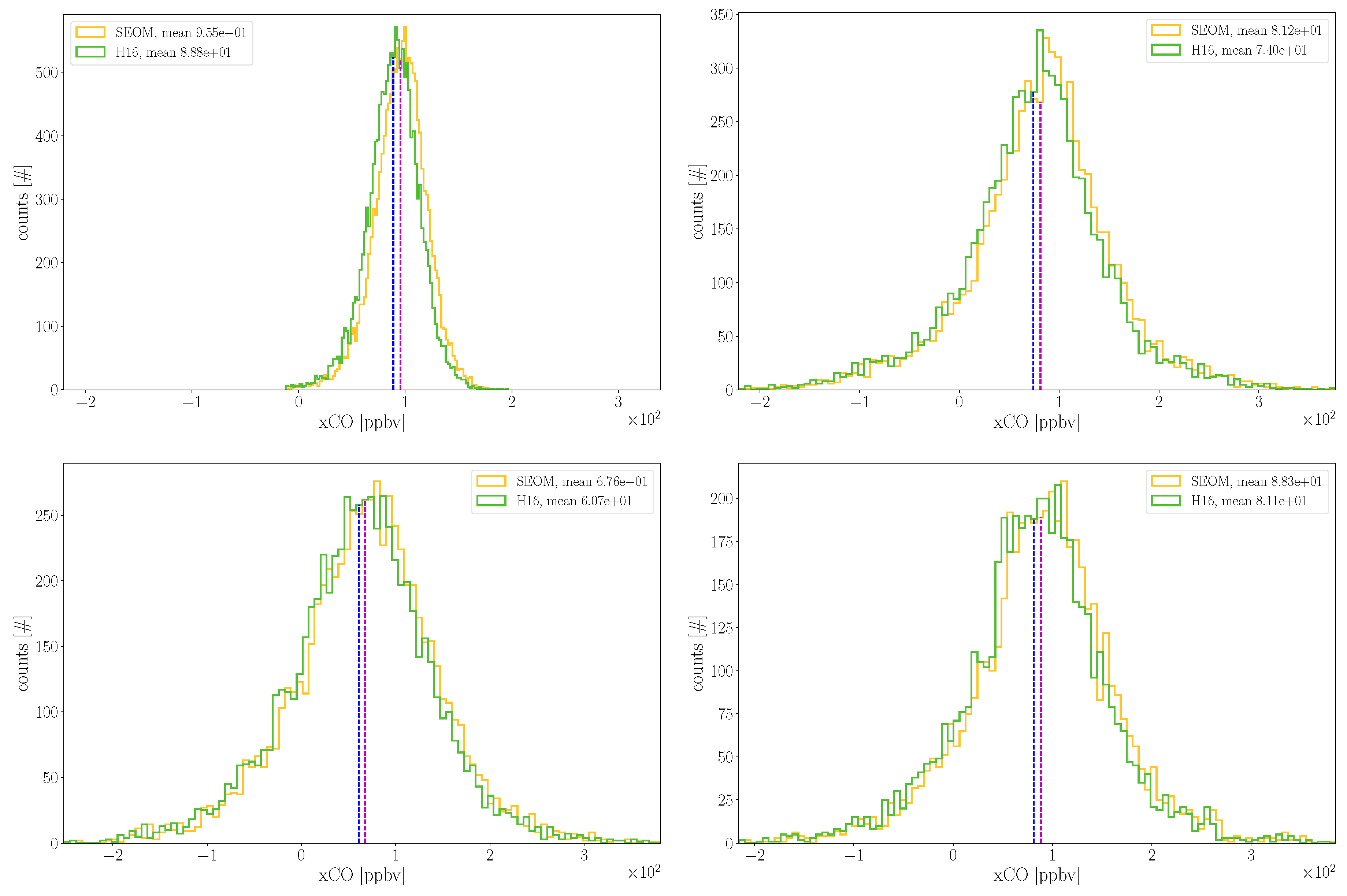
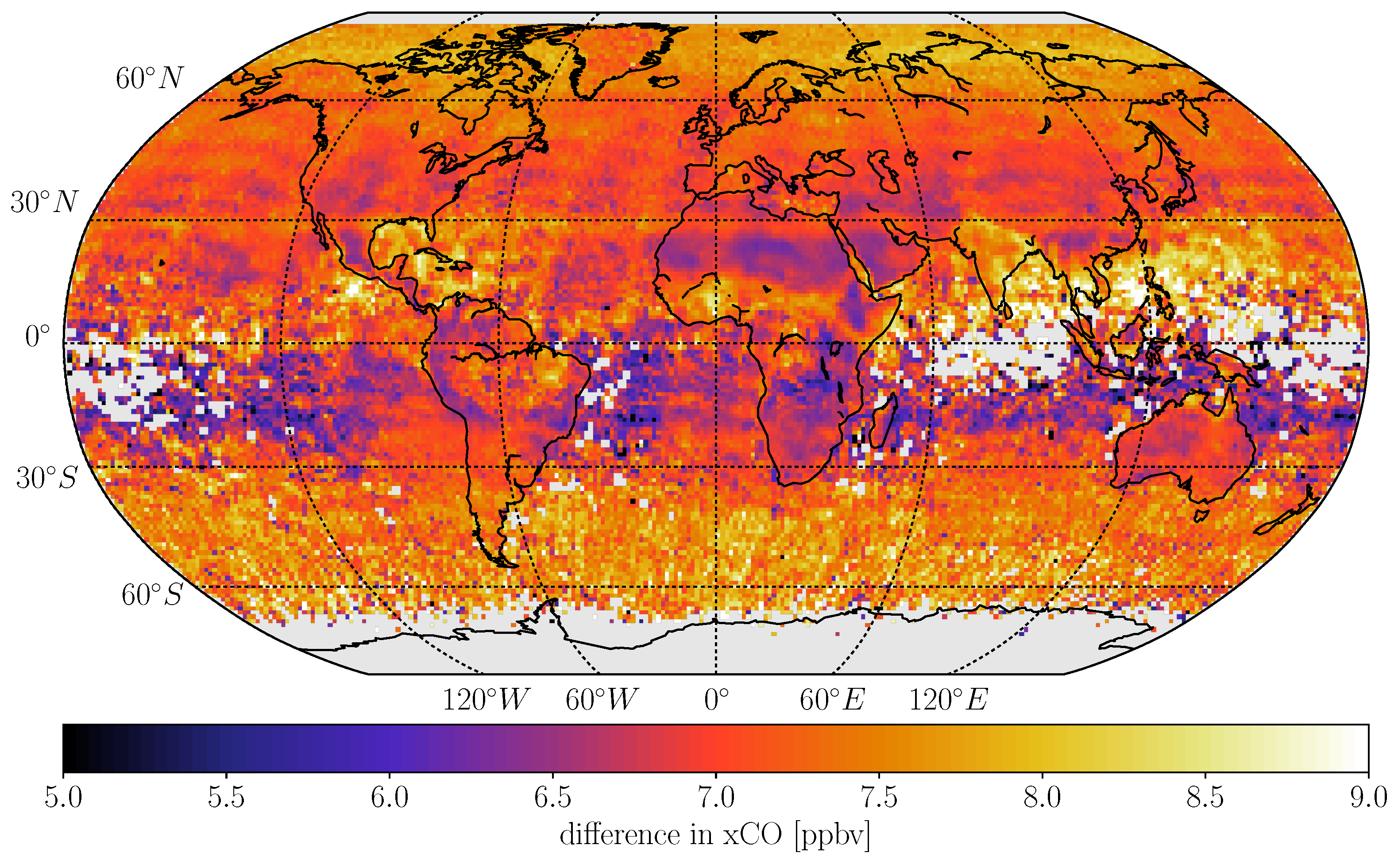
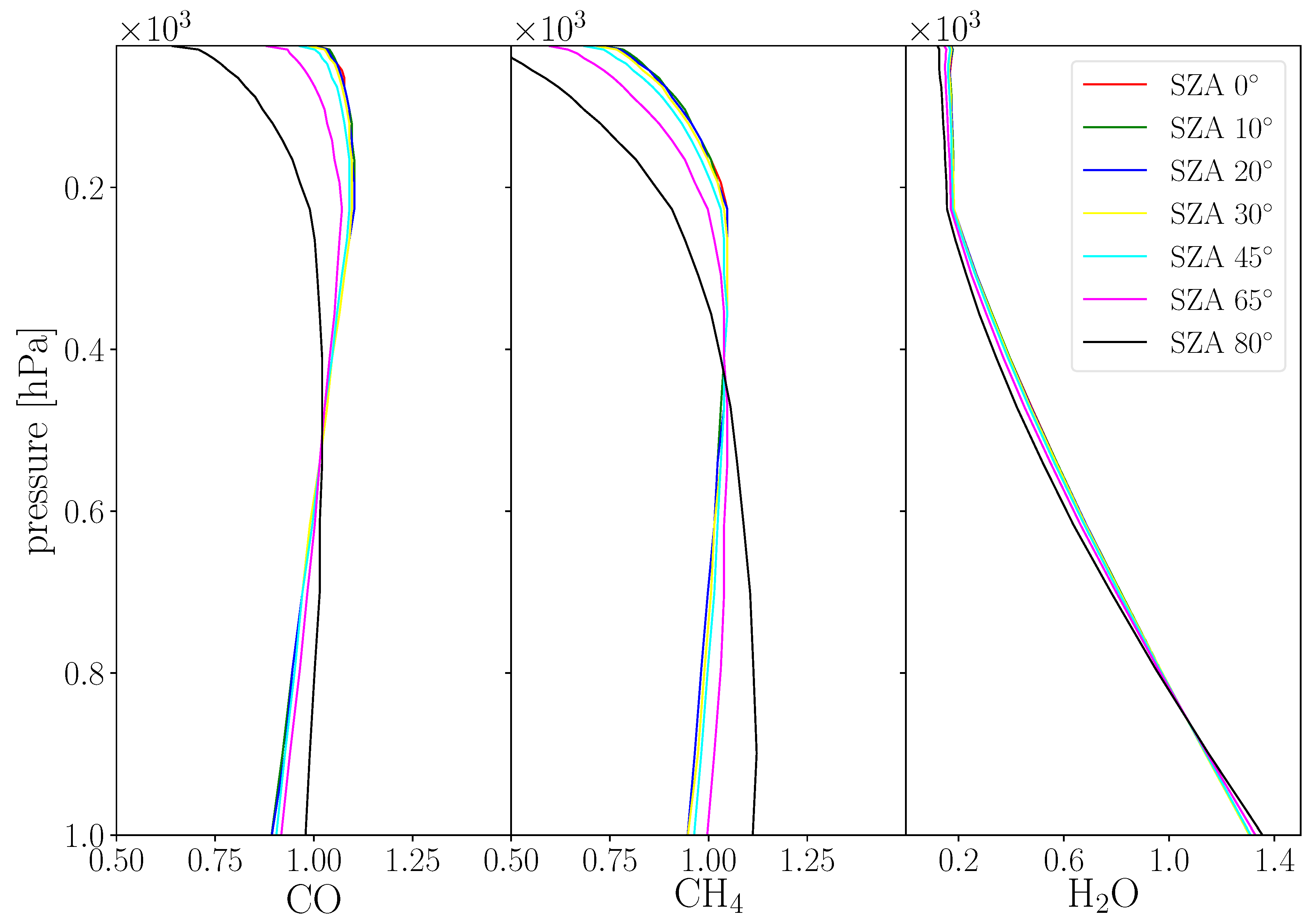
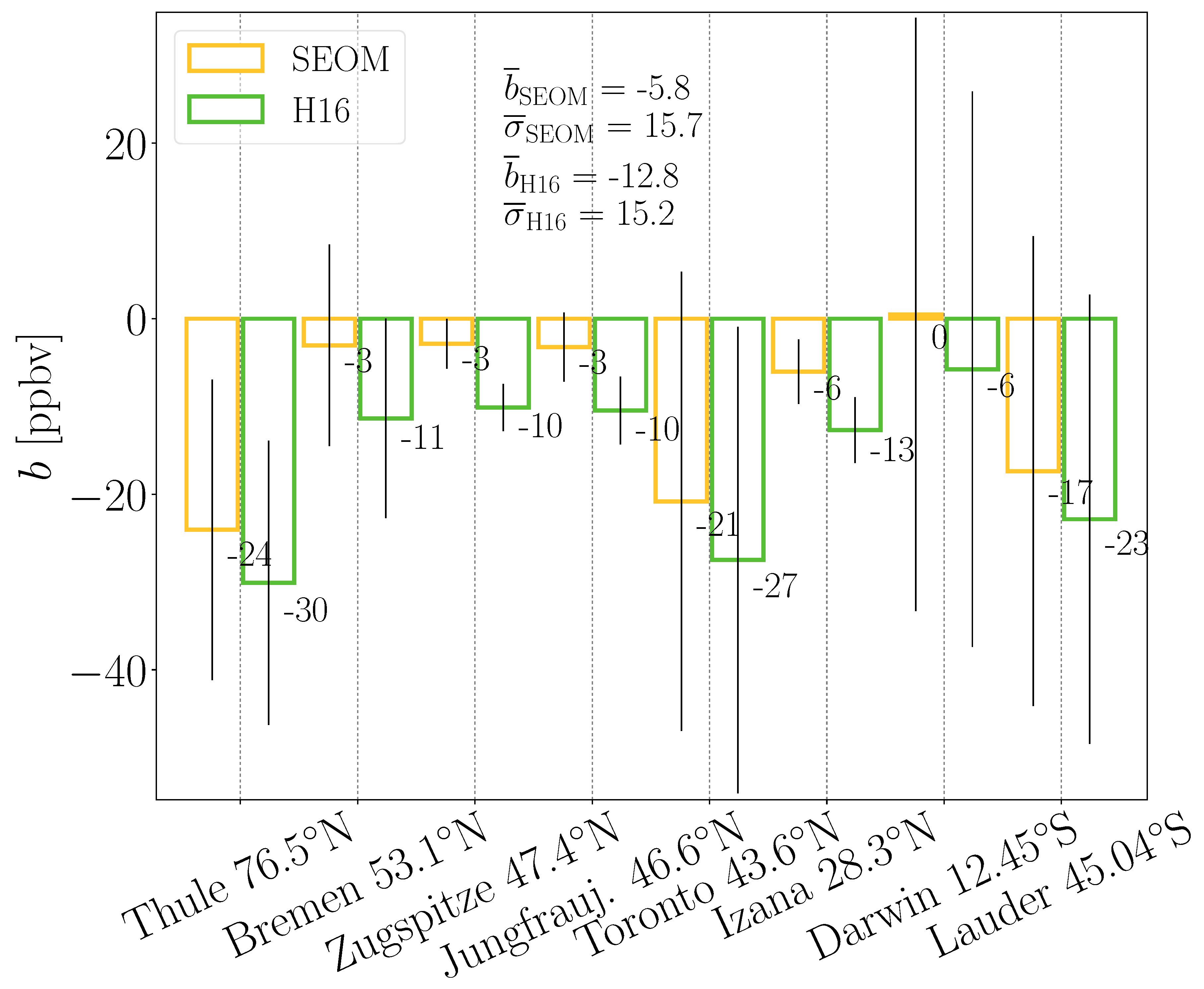
| Gas | Data | # Lines | n | ||||
|---|---|---|---|---|---|---|---|
| CO | G15 | 160 | – | 0.040–0.079 | 0.69 | ||
| H16 | 110 | – | 0.042–0.081 | 0.67–0.79 | |||
| seom | 110 | – | 0.042–0.081 | 0.67–0.79 | 0.00607(10) | 0.0047(10) | |
| CH | G15 | 7213 | – | 0.034–0.077 | 0.46–0.97 | ||
| H16 | 8375 | – | 0.034–0.077 | 0.67–0.77 | |||
| seom | 6205 | – | 0.019–0.182 | 0.19–1.82 | 0.008405(610) | 0.00911(65) | |
| HO | G15 | 1101 | – | 0.004–0.096 | 0.32–0.69 | ||
| H16 | 1197 | – | 0.004–0.109 | 0.32–0.73 | |||
| seom | 1177 | – | 0.004–0.141 | 0.31–1.02 | 0.007197(35) | 0.01083(12) |
| Quantity | Spatial Extend | Temporal Coverage | |
|---|---|---|---|
| Section 3.1.1 | spec. residuum | single orbits | overpasses in 2003 & 2004 |
| Section 3.1.2 | spec. residuum | regional scale | April 2004 |
| Section 3.2 | mole fraction | regional scale | April–June 2004 |
| Section 3.3 | mole fraction | within 1000 km from site | April–June 2004 & August–October 2005 |
| Section Appendix A.1 | mole fraction | global scale | April–June 2004 |
| Data | Model | Median | std. dev. | ||||
|---|---|---|---|---|---|---|---|
| SEOM | SDRM | ||||||
| SEOM | SDVM | ||||||
| SEOM | Rautian | ||||||
| SEOM | Voigt | ||||||
| HITRAN 2016 | Voigt | ||||||
| GEISA 2015 | Voigt | ||||||
| Region | Latitude | Longitude | Discarded Obs. | # Survivors | |
|---|---|---|---|---|---|
| Sahara | 18N–30N | 004W–026E | 14% | 1234 | −6.89% |
| Siberia | 55N–66N | 066E–095E | 60% | 1104 | −10.25% |
| Amazonia | 08S–03N | 078W–051W | 54% | 1084 | 0.14% |
| CaPaAl | 49.5N–58.5N | 117W–140W | 49% | 683 | −14.71% |
© 2020 by the authors. Licensee MDPI, Basel, Switzerland. This article is an open access article distributed under the terms and conditions of the Creative Commons Attribution (CC BY) license (http://creativecommons.org/licenses/by/4.0/).
Share and Cite
Hochstaffl, P.; Schreier, F. Impact of Molecular Spectroscopy on Carbon Monoxide Abundances from SCIAMACHY. Remote Sens. 2020, 12, 1084. https://doi.org/10.3390/rs12071084
Hochstaffl P, Schreier F. Impact of Molecular Spectroscopy on Carbon Monoxide Abundances from SCIAMACHY. Remote Sensing. 2020; 12(7):1084. https://doi.org/10.3390/rs12071084
Chicago/Turabian StyleHochstaffl, Philipp, and Franz Schreier. 2020. "Impact of Molecular Spectroscopy on Carbon Monoxide Abundances from SCIAMACHY" Remote Sensing 12, no. 7: 1084. https://doi.org/10.3390/rs12071084
APA StyleHochstaffl, P., & Schreier, F. (2020). Impact of Molecular Spectroscopy on Carbon Monoxide Abundances from SCIAMACHY. Remote Sensing, 12(7), 1084. https://doi.org/10.3390/rs12071084






